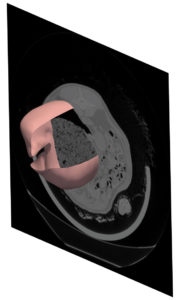Modelling the Effect of Rumen Biomechanics on Digestion
- Organisation: Auckland Bioengineering Institute and DairyNZ
- Grant Number: A16006
- Grant Amount: $52,200
 The rumen and its microbes are the engine that drives ruminant production and health. While the microbial and chemical aspects of rumen fermentation have been well studied, the physical aspects of processing – mixing and outflow of digesta, particle sorting and filtering and the rumen contractions that drive these – are not well understood. Recent work in New Zealand has shown that these aspects are closely linked to methane emissions and feed conversion efficiency in both sheep and cattle. The work completed by University of Auckland developed the first three-dimensional map of rumen shape, contraction patterns and digesta mixing in sheep using a combination of ultrasound and CT scanning of live animals and computer simulation techniques.
The rumen and its microbes are the engine that drives ruminant production and health. While the microbial and chemical aspects of rumen fermentation have been well studied, the physical aspects of processing – mixing and outflow of digesta, particle sorting and filtering and the rumen contractions that drive these – are not well understood. Recent work in New Zealand has shown that these aspects are closely linked to methane emissions and feed conversion efficiency in both sheep and cattle. The work completed by University of Auckland developed the first three-dimensional map of rumen shape, contraction patterns and digesta mixing in sheep using a combination of ultrasound and CT scanning of live animals and computer simulation techniques.
The long-term vision is to integrate simulation models of the physical and chemical aspects of rumen fermentation so that we can understand how factors such as feed properties, rumen fill, feeding frequency affect throughput and efficiency. The work has already provided interesting insights into the role of rumen size on methane emissions and the role of the reticulum in regulating particle outflow from the rumen.
“With AGMARDTs support we were able to assemble a team that brought together expertise in rumen physiology, medical imaging, and computational modelling from the Auckland Bioengineering Institute, DairyNZ and AgResearch to complete this ground-breaking work.
AGMARDT funding was also crucial for supporting the PhD studies of Stephen Waite who carried out the measurements and modelling.” Vinod Suresh, Senior Lecturer, Auckland Bioengineering Institute, University of Auckland
CT scanning section of sheep showing rumen outline. Colours indicate the speed of digesta flow
as the rumen contracts (red is faster and green slower).
We are grateful for the assistance the AGMARDT Grant provided. It has allowed Freshco to direct sales and manage our own destinies in each market enabling us to extract more value from the supply chain to the consumer.
John Mangan / Director, Freshco
AGMARDT supports and enables. Projects and people benefit from funding; New Zealand benefits from development of ideas, technologies, approaches and leadership. In particular, the trust facilitates information dissemination: AGMARDT is the catalyst for ripples that spread through the primary sector.
Dr Jacqueline Rowarth /
AGMARDT's support of Texus in the above process tangibly accelerated the development of the above essential activities and testing of market entry strategy, while also exposing Texus management to cutting-edge thought leadership around market shaping and the levers that can be applied to scope and facilitate such shaping.
Nick Davenport / CEO, Texus Fibre Industry Leader Scholarship Winner
The support from AGMARDT has enabled us to gain greater insights into farmer behaviour across all sectors and which will assist accelerated uptake of the livestock exchange and enhance market opportunities for all farmers.
Jason Roebuck / Managing Director, Stock-X Limited

